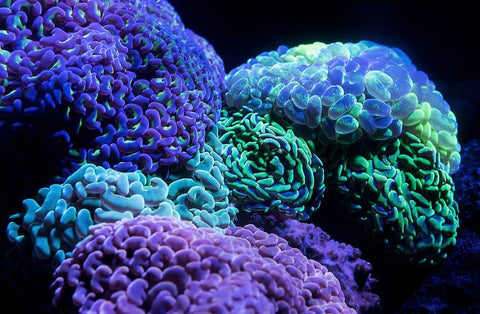Tank Stocking
Share

Once the tank has been fully cycled it is time to start to add fish, corals and invertebrates. Like everything in the reefing hobby, the key is to take things slow and not overwhelm the tank’s biofilter. While specific fish choices are very much dependent on tank size, it is a good idea to start with fish that have reputations for being hardy and easy to feed. While a Mandarin Dragonet makes a stunning addition to a mature tank, they are notoriously picky eaters and are not recommended for beginners. Good choices for a novice reefer include the Clownfish, Royal Gramma, Green Chromis and various types of Gobies. Just be sure to do some research about any fish you are considering adding to make sure they will be a good fit for your new tank. It is also important to add fish slowly over time rather than all at once to allow the tank to adjust to the increased bioload.
A varied clean up crew is essential for keeping your new reef tank free of algae, uneaten fish food and other types of detritus. While a variety of snails will form the backbone of the clean up crew there are also other useful members.

For example, hermit crabs come in a wide variety of sizes and colours and are useful for getting into cracks between the rockwork and keeping the sandbed clean. It is, however, important to ensure that a wide variety of empty shells are available to deter hermit crabs from preying on snails for their shells. Over time many reefers will also choose to add a sand sifting starfish and a conch in order to keep the sandbed clean.

Larger tanks may eventually house an urchin, emerald crabs and other specialized clean up crew members. Just like stocking with fish, it is important to add clean up crew members slowly in order to ensure that there is enough food for them.

Probably the most exciting thing about starting a reef tank is adding the first corals. While it may be tempting to try and recreate one of those stunning acropora dominated tanks that are all over Instagram, new reefers should start slowly with easier to keep corals before moving on to more difficult specimens. Soft Corals make a great introduction to keeping corals as they are more tolerant of less than ideal water conditions and are generally quite hardy. Some members of the Euphyllia family, such as hammer corals and frogspawn, are a great way to add colour and movement to a reef tank. Whatever corals you choose to add, it is important to give them space to grow and to consider isolating very fast growing corals such as Green Star Polyps on their own rock island to prevent them from taking over. Reef keeping is an amazingly rewarding hobby and adding those first corals is a huge step towards future reefing success.

